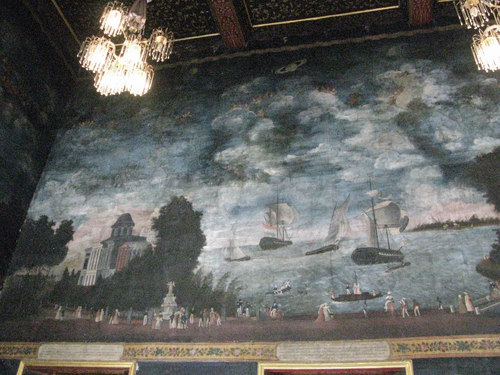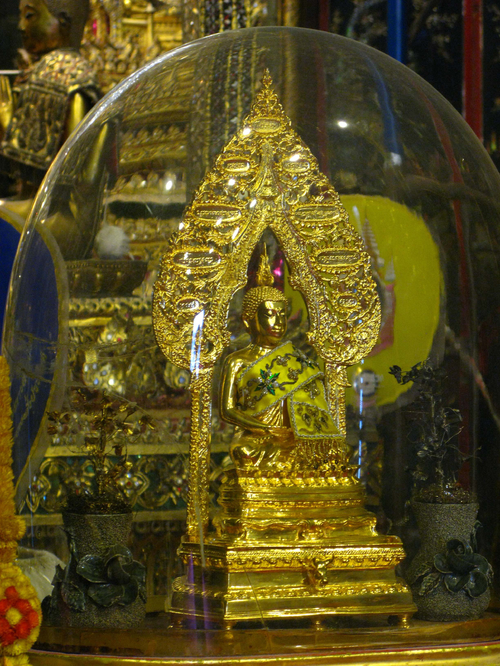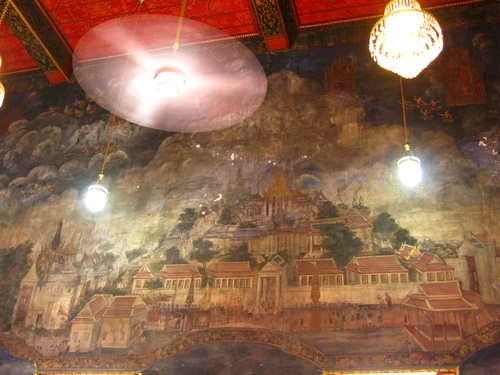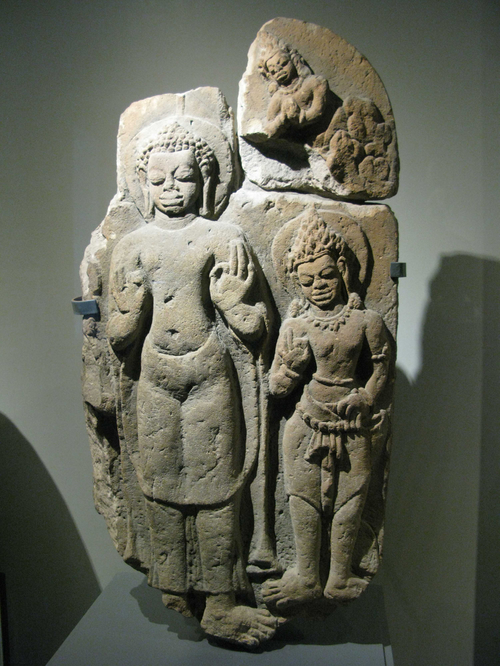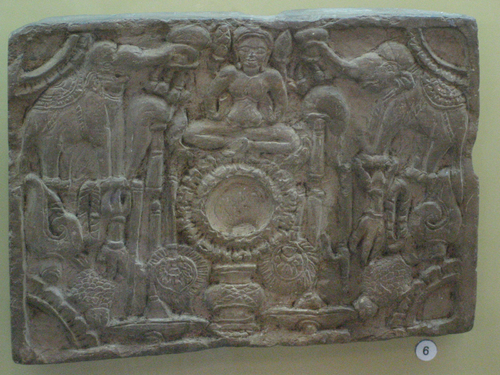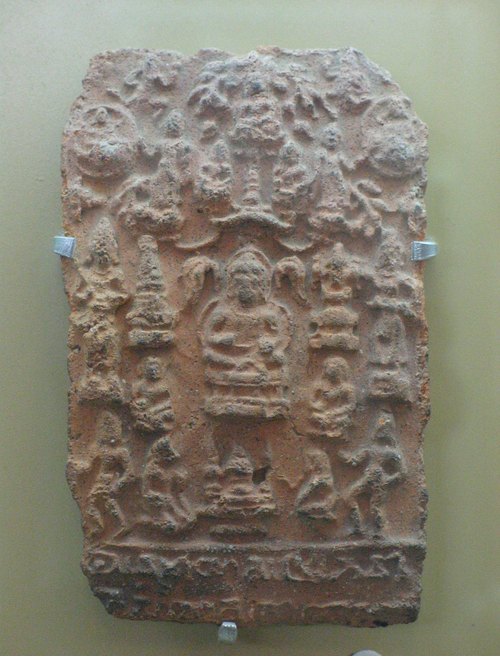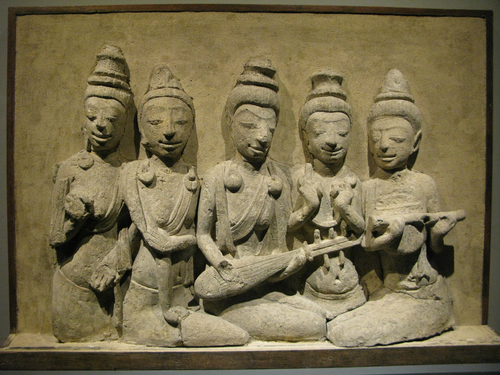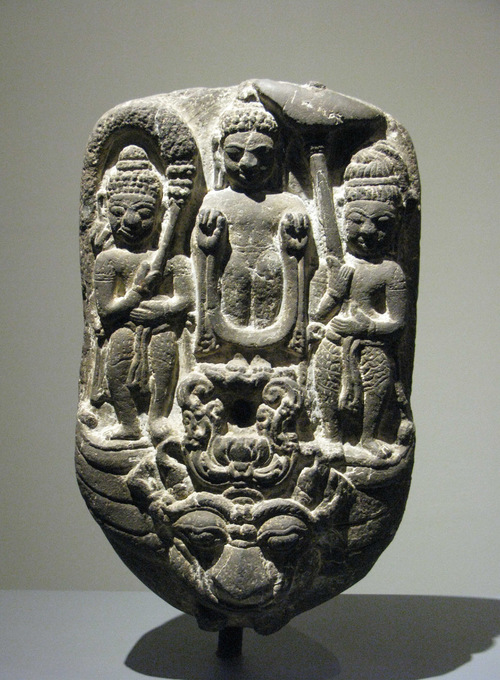ค้นหางานศิลปกรรม
ฐานข้อมูลศิลปกรรมในเอเชียตะวันออกเฉียงใต้
จิตรกรรมจิตรกรรมฝาผนังเรื่องปริศนาธรรม
ภาพจิตรกรรมเขียนด้วยสีฝุ่น โทนสีโดยรวมค่อนข้างมืดครึ้ม ใช้หลักทัศนียวิทยา (perspective) อย่างตะวันตก โดยกำหนดเส้นขอบฟ้าเพื่อเป็นจุดนำสายตา ก่อให้เกิดมิติเนื่องจากการแสดงระยะใกล้-ไกลของวัตถุหรือบุคคลในภาพ ใช้เทคนิคการเกลี่ยสีและให้แสงเงา ซึ่งแตกต่างจากการระบายสีแล้วตัดเส้นแบบจิตรกรรมไทยประเพณี ภาพบุคคลแต่งกายแบบตะวันตก เช่นเดียวกับอาคารบ้านเรือนที่เป็นสถาปัตยกรรมแบบยุโรป แม้ภาพโดยรวมจะมีรูปแบบอย่างตะวันตก แต่ยังคงปรากฏภาพเทวดานางฟ้าแต่งกายทรงเครื่องอย่างไทยประเพณีอยู่ในท่าเหาะบนท้องฟ้าที่มีก้อนเมฆและกลุ่มดาวต่างๆ ที่ใต้ภาพปริศนาธรรมแต่ละห้องมีข้อความอธิบายความหมายของแต่ละภาพ
ประติมากรรมพระนิรันตราย
พระนิรันตรายเป็นพระพุทธรูปปางสมาธิ ประทับนั่งขัดสมาธิเพชร ครองจีวรห่มเฉียง สังฆาฏิเป็นแผ่นสี่เหลี่ยมเรียบขนาดใหญ่อย่างเหมือนจริงทับจีวรที่มีริ้วอย่างเป็นธรรมชาติ พระพักตร์มีรูปแบบคล้ายกับมนุษย์มากยิ่งขึ้น โดยเฉพาะใบพระกรรณที่หดสั้นลง ที่สำคัญคือไม่มีอุษณีษะ แต่ยังคงทำรัศมีเปลว ขมวดพระเกศา และมีอุณาโลมตามลักษณะมหาบุรุษ พระพุทธรูปประทับนั่งเหนือฐานสิงห์ มีรูปศีรษะโคที่ด้านล่าง ซึ่งมีความหมายถึงโคตมะ รอบองค์พระพุทธรูปประดับด้วยซุ้มเรือนแก้วประกอบกับซุ้มไม้โพธิ์ซึ่งมีคาถาพระพุทธคุณหรือบทอิติปิโส ซึ่งเป็นคาถาพระราชนิพนธ์ในรัชกาลที่ 4
จิตรกรรม จิตรกรรมเรื่องสังคายนาพระไตรปิฎก
จิตรกรรมฝาผนังเขียนเล่าเหตุการณ์การสังคายนาพระไตรปิฎกในพุทธศาสนารวมทั้งสิ้น 9 ครั้ง เริ่มจากผนังด้านขวาของพระประธาน ซึ่งเป็นเหตุการณ์ในอินเดีย เรียงลำดับไปยังผนังด้านหลังซึ่งเป็นเหตุการณ์ในลังกา และผนังด้านซ้ายซึ่งเป็นเหตุการณ์ในล้านนาและในสมัยรัชกาลที่ 1 ผนังเบื้องหน้าพระประธานเขียนภาพตู้พระไตรปิฎก 3 ตู้ ซึ่งน่าจะหมายถึงพระไตรปิฎกที่ได้รับการสังคายนาแล้ว ได้แก่ พระวินัยปิฎก พระสุตตันตปิฎก และพระอภิธรรมปิฎก ภายในตู้บรรจุพระคัมภีร์ห่อด้วยผ้ายกปิดทอง มีภาพผู้คนหลากหลายเชื้อชาติ สังเกตได้จากการแต่งกายที่แตกต่างกันกำลังกราบไหว้บูชาตู้พระธรรมเหล่านั้น
ประติมากรรมใบเสมา
ใบเสมาแบบแผ่นแบน ชำรุดเสียหายมาก แต่ยังเห็นภาพสลักเรื่องได้ชัดเจน พระพุทธองค์ยืน พระหัตถ์ทำปางแสดงธรรมทั้ง 2 ข้าง พระพักตร์เหลี่ยม พระเนตรเหลือบต่ำและโปนใหญ่ พระนาสิกใหญ่ พระโอษฐ์แบะกว้างพระพุทธองค์ครองจีวรห่มคลุม ชายจีวรด้านหน้าพาดผ่านพระชานุเป็นรูปโค้ง ขณะที่ชายจีวรด้านหลังตกลงมาเป็นกรอบสี่เหลี่ยมยาวจนถึงข้อพระบาท สบงยาวจรดข้อพระบาทเช่นกันเบื้องซ้ายของพระองค์มีภาพบุคคลขนาดเล็กสวมเครื่องทรงดังเทวดายืนเคียงข้าง ถัดขึ้นไปมีเทวดาประนมกรแทรกกายอยู่หลังเมฆ จากภาพถ่ายเก่าทำให้เห็นว่าภาพทางเบื้องขวาของพระองค์มีการจัดวางองค์ประกอบแบบนี้เช่นกัน แต่ปัจจุบันได้ชำรุดสูญหายแล้ว ไม่ทราบว่าเป็นพุทธประวัติตอนใด แต่นักวิชาการบางท่านสันนิษฐานว่าเล่าพุทธประวัติตอนเสด็จลงจากสวรรค์ชั้นดาวดึงส์ เพราะมีเทวดาขนาบอยู่ 2 ข้าง
ประติมากรรมแผ่นหินสลักภาพมงคล
แผ่นหินรูปสี่เหลี่ยมผืนผ้า ตรงกลางและมุมทั้งสี่มีหลุมตื้นๆ ที่ล้อมรอบด้วยกลีบบัว อาจใช้สำหรับใส่พวกเครื่องหอมที่ใช้ในพิธีกรรม ตอนบนของแผ่นหินมีช้าง 2 เชือกทำท่าสรงน้ำให้สตรีซึ่งนั่งอยู่ตรงกลาง นักวิชาการเรียกภาพนี้ว่า “คชลักษมี” หรือ “อภิเษกศรี” ด้านล่างปรากฏสัญลักษณ์มงคลต่างๆ และมีส่วนหนึ่งเป็นเครื่องสูงประกอบอยู่ด้วย ทั้งหมดสลักเป็นคู่ๆ ได้แก่ จามร (แส้) วัชระ (สัญลักษณ์ของสายฟ้า) อังกุศะ (ขอสับช้าง) พัด ฉัตร บ่วง ส่วนภาพ ปลา สังข์ และปูรณกลศ (หม้อ) 1 ใบ
ประติมากรรมพระพิมพ์
พระพิมพ์แสดงภาพเล่าเรื่องพุทธประวัติตอนแสดงยมกปาฏิหาริย์ที่เมืองสาวัตถีเพื่อปราบเหล่าเดียรถีย์นี้ พระพุทธเจ้านั่งสมาธิบนบัลลังก์ซึ่งวางอยู่ใต้ต้นมะม่วง มีแส้กางกั้นเหนือพระเศียร แส้ปักอยู่ 2 ข้าง ถัดออกไปเป็นภาพคล้ายสถูป ทั้งสองข้างแวดล้อมด้วยภาพบุคคลจำนวนมาก คงมีทั้งบุคคลในโลกมนุษย์ และทิพยบุคคลจากสวรรค์ถัดขึ้นไปด้านบนตามกิ่งก้านของต้นมะม่วงปรากฏภาพพระพุทธนิรมิตในอิริยาบถต่างๆ 5 องค์ เบื้องล่างสุดมีตัวอักษรเขียนคาถา เย ธมฺมา ปรากฏอยู่
ประติมากรรมปูนปั้นรูปนักดนตรี
ประติมากรรมปูนปั้นนี้ทำรูปสตรี 5 คน นั่งพับเพียบเรียงกัน สวมเฉพาะผ้านุ่ง ท่อนบนมีเพียงผ้าคล้องไหล่ไว้เท่านั้น สตรีทางซ้ายสันนิษฐานว่ากำลังตีกรับ สตรีคนถัดมาน่าจะทำหน้าที่ขับร้อง สตรีคนกลางถือเครื่องดนตรีประเภทพิณ 5 สาย คล้ายกระจับปี่หรือซึง สตรีคนถัดมาทำหน้าที่ตีฉิ่ง และสตรีทางขวาสุดกำลังดีดพิณ
ประติมากรรมพระพุทธรูปประทับเหนือพนัสบดี
พระพุทธเจ้ายืนอยู่บนดอกบัวที่วางอยู่เหนือพาหนะ ขนาบข้างด้วยบุคคลข้างละ 1 คน พระหัตถ์ทั้งสองข้างทำปางแสดงธรรม มีรูเจาะทะลุปรากฏอยู่บริเวณฐานบัว พาหนะทำเป็นรูปสัตว์ผสมลักษณะเด่นคือ มีปีก มีจะงอยปากแหลม มีเขา นิยมเรียกพาหนะแบบนี้ว่า ตัวพนัสบดี รูปบุคคลยืนที่ยืนอยู่สองข้างนั้น ข้างหนึ่งถือแส้ ข้างหนึ่งถือฉัตร น่าจะเป็นพระอินทร์และพระพรหม
